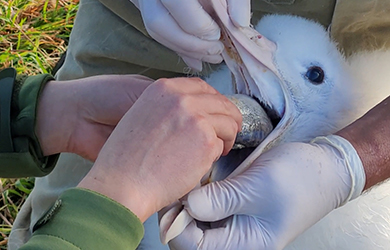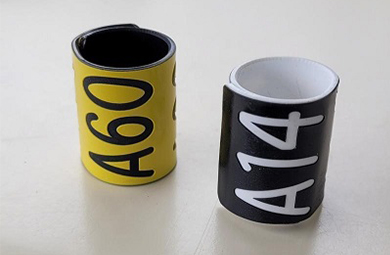Ranger's work for royal albatross
Introduction
Discover the work DOC rangers do on and off Royal Cam to support royal albatross on Taiaroa Head.The DOC rangers seen on Royal Cam are part of the Taiaroa Head Albatross Team. We are a group of 4 to 5 rangers who work a roster of 7 days all year round. We check on all albatross, eggs and/or chicks on the headland each day.
To lessen the risks to royal albatross, we:
- incubate eggs
- manage breeders who incubate for lengthy periods
- create foster nests
- feed chicks
- keep birds cool
- protect chicks from flies and predators.
Rangers also keep records, band birds and maintain the colony grounds. Find out about the work we do during specific periods of royal albatross' life cycle:
Incubation due to long changeovers
Albatross can easily go for 2 weeks without food. However, sitting on a nest for 2 weeks in the summer heat can cause dehydration.
Monitoring has shown that an albatross could desert the egg after 13 days for self-preservation. To mitigate the risk to the egg, we remove any egg from a breeder who has been on the nest for 13 days. The egg goes to the incubator for safe keeping and a dummy egg is placed in the nest. The mate who has been away will likely continue to incubate a deserted dummy egg if they return to the nest and it is deserted. Potentially normal changeovers can resume.
If no changeover has occurred on day 14 or 15 the adult on the nest will be hydrated with 600 ml of fluid with vitrate (hydration support).
Video of OGK being hydrated on day 15.
On day 17 or 18 further hydration and supplementary feeding will start and continue until either the mate returns or it is considered that the bird on the nest would be better of being released, usually by day 25. At this point the dummy egg would be removed and the bird would leave with there being nothing to incubate.
Work to protect newborn chicks
During hatching rangers work two shifts daily. This ensures rangers are on site during the long daylight hours of summer to protect albatross eggs and chicks.
Preventing flystrike
After chicks make a hole in the tough shell of their egg, flies can lay maggots on the egg or the young chick ('flystrike') which can lead to their death. Staff hatch all the chicks in incubators leaving a dummy egg in the nest. The nest is sprayed with Avian Insect Liquidator (AIL) when the hatching egg is removed and on return of the day old chick who has had AIL applied also. This has significantly reduced fly-strike.
In this ‘Behind the Scenes’ video you can see the hatching chick and why it is so vulnerable to fly-strike. On hot or even only mild days if the parent stands up this exposed hatchling would be a fly magnet.
Keeping albatross cool
If we see albatross heavily panting (gular fluttering) or standing to cool their legs, they are likely to be overheating and could potentially desert the nest. Each nest has a small riser and its own tap on a length of piping that can be moved away from the bird while adjusting the mist spray So, we target cooling water using a tap and riser at each nest to adjust the waterflow.
Albatross nests are spread over about 200 m2 of Pukekura/Taiaroa Head each with their own micro-climate. Twp water lines cover the entire colony, the length of piping is just over 1 km. Hottest nests are targeted first. It is not necessary to spray mild panting as this is the birds natural mechanism to cool themselves down.
Controlling introduced predators
Introduced predators such as stoats, ferrets and feral cats are one of the biggest risks to newborn albatross chicks. Rangers work hard to set and maintain traps on and near the headland. Chicks are most at risk when they are 2-6 weeks old, but by the time they are a couple of months old (and around 3-4 kg) they can defend themselves.
Organisations such as the Pukekura Trust, Penguin Place, Nature's Wonders and the Dunedin City Council's Task Force Green also help by trapping in the nearby area. These traps also help with protecting the many other seabirds found on the headland, such as penguins, shags, and shearwaters.
DNA testing for record keeping
We use a tiny blood sample from the chick to perform DNA analysis to know the chick’s sex. This helps us to know if their weight is healthy, as males become heavier than females after a few months. We then send the samples to the University of Otago’s Zoology Department for analysis.
Support for growing chicks
Rangers support the growing chick on Royal Cam and many more chicks in the colony too. To support all the chicks in the colony, we check to see if each is a healthy weight and provide additional feedings if required.
Monitoring and feeding

Supplementary feeding of an albatross
Image: Sharyn Broni | DOC
We monitor each chick and their weight every year. We’ll weigh and feed them if they are underweight, and no other albatross can.
Rangers weigh the chicks daily until it reaches 14 days old. After 14 days, we weigh them weekly until they fledge in September. We also monitor when their parents swap egg warming and food gathering duties to track if the chick has a parent with food to give it.
If rangers find the chick is underweight for its age, or if a parent is late in returning from sea, we may feed the chick. Rangers feed very young chicks well-blended fish smoothies, to avoid any lumps that could get caught in their throats. As they grow up the size of the fish can be increased to whole fish.
Foster placements of vulnerable chicks
Foster nests are those where a pair have laid an infertile egg, or an egg has died and the parents are available to raise another pairs' chick. Rangers place dummy eggs here to keep the pair on the headland in case a nest is deserted, or a chick awaiting a parent needs fed.
DOC rangers note when adult albatross come and go from the nest to track when chicks are being fed. Strong or calm winds can make landing difficult for albatross parents returning from sea to feed their chick. Being unable to find food can also prevent albatross parents from returning.
It’s best for an adult albatross to feed a chick. So, when an adult has not returned for around 13 days, we move the egg or chick to a foster nest and try to return the egg or chick if they return. If there are no foster pairs, then DOC rangers will feed the chick until it fledges.
Interacting to keep albatross calm
Rangers are experienced at handling albatross and are trained to move carefully around the birds to minimise any negative reactions. Ranger work is aided by the fact that albatross have evolved without land predators and need to be very loyal to the nest if they hope to raise a chick.
Until the chick is at least 6 weeks old, albatross will tolerate rangers, but may not want us there. After 6 weeks, the adult will move away when we are nearby as the chick is in post guard stage and the parent does not need to shelter is.
Our understanding of their behaviour minimises the chance of being bitten. For example, a little tap on the bill replicates the bonding behaviour between a pair. Occasional bites happen, and it can hurt, but we stay relaxed and work to keep the birds calm so we can continue to support them.
Banding fledging birds

New Darvic bands
Image: DOC
We band albatross chicks when they are 6 months old. A stainless-steel band goes on their right leg with a unique 5 or 6-digit number. On the left leg males receive a black band with the season letter and a 2-digit number. The females receive a yellow band with the season letter and a 2-digit number.
Bands help us identify the chicks as they move around the colony prior to fledging and we can be certain of the identification when they return in 5-years time.
Bands for the season
We place a single colour plastic band with a one or two-digit number on each chick. This number is unique to them and is so we can identify them for our record-keeping that season. It helps us identify them as they move around the colony.
Banding for adulthood
We are currently changing over the banding system for adults to a new one.
Previously once the adolescents return from several years at sea, we replace the single plastic band with a two or three colour band combination.
We read the bands from the top down according to the first letter of the colour. For example, O is for orange, G is for Green. The one exception is K for black as B was already in use for blue when we started to use black bands.
The new system of darvic bands means that prior to a chick fledging the darvic band will be one that they keep for life. Adolescents that are returning without an adult band will be banded with an A darvic band. Older adults who need a band replacement will be banded with a Z darvic band.
